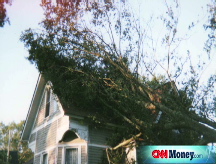Who benefits from the new Fannie-Freddie plan
A new housing rescue plan from the administration targets some of the most troubled homeowners.
| 30 yr fixed | 3.80% |
| 15 yr fixed | 3.20% |
| 5/1 ARM | 3.84% |
| 30 yr refi | 3.82% |
| 15 yr refi | 3.20% |
NEW YORK (CNNMoney.com) -- Mortgage giants Fannie Mae or Freddie Mac may back 30 million mortgages. But that doesn't mean that the new foreclosure prevention program announced this week by the Bush administration will rescue every troubled borrower on their books.
The Federal Housing Finance Agency (FHFA), which took control of Fannie (FNM, Fortune 500) and Freddie (FRE, Fortune 500) in September, together with Hope Now, the coalition of lenders, servicers, investors and community groups, designed the plan to help some of the most at-risk homeowners.
"Foreclosures hurt families, their neighbors, whole communities and the overall housing market," said James Lockhart, director of FHFA in a release. "We need to stop this downward spiral."
The plan, which begins on Dec. 15, is open to borrowers with loans owned or backed by Fannie and Freddie who are at least 90 behind with their mortgage payments. But in reality, qualifying for the program will probably be a lot more complicated than meeting these two requirements. In the end, it's probable that only a relatively narrow swath of people will benefit from the initiative.
About 1.22% of Freddie's 12 million loans are 90 days or more late, while 1.7% of Fannie's 18 million loans are that far past due. That's a total of more than 450,000 borrowers, however it's unlikely that all or even most of them will get help.
"Some people may be technically eligible but not practically eligible," due to factors like an extremely low income, according to Keith Gumbinger, of mortgage research firm HSH Associates. "I wish someone would get a clear handle on how many people it could actually help," he said.
Fannie and Freddie are only targeting homeowners who are more than three months past due on their loans in order to ensure that the most troubled borrowers get help immediately.
Beyond that, borrowers will have to write what's called a "hardship letter" to illustrate that they fell behind for a good reason - whether it's a a job loss, divorce or a medical problem. If they can't show that, they don't get a fix.
Another condition: Borrowers cannot have too much equity in their homes. If their home's current market value exceeds their mortgage balance by more than 10%, they're considered too well off to participate. Instead, these borrowers have the option to tap that home equity, either by refinancing or taking out a home equity loan, to get current with their payments.
And some borrowers are simply too far gone to help according to Brad German, a spokesman for Freddie Mac. Those with a mountain of debt and little income may need a much more drastic modification than any lender would be prepared to issue.
"Borrowers have to have some income," said Faith Schwartz, director of Hope Now. "The property has to [provide] cash flow somehow for the lender."
But Schwartz cautions that even borrowers in very bad shape should contact their lenders. They may not qualify for a loan workout, but a bank may be willing to do a short sale or a deed in lieu of foreclosure. In a short sale the lender agrees to let the borrower sell the property for less than what the mortgage is worth and forgive the difference. In a deed in lieu of foreclosure the borrower essentially gives the house back to the bank.
Either of these options will do a lot less damage to a borrower's credit score.
Finally, not everyone who could benefit from the program will chose to participate. Surprisingly, many borrowers who are in trouble just don't do anything; they don't contact their banks and they ignore their lender's phone calls and letters.
Although the program may not have a massive impact, according to Schwartz it's still a welcome supplement for the many other plans - FHA Secure, Hope for Homeowners and programs from individual lenders - already in place.
And officials hope that it will provide an easy-to-apply template for other modification programs.
"It's an important step forward for the industry to establish clear-cut guidelines, that make it easier for servicers to act on modifications and for borrowers to understand what is involved," said Schwartz.
Lenders will look at their portfolios for borrowers who qualify, and then send out letters informing them that help is available and asking the borrowers for financial information, such as pay stubs and bills, as well as hardship letters.
Then the banks will use that information to determine if they can keep a borrower in their home by reducing their monthly payment to no more than 38% of their gross income. To do that, they can lower interest rates to as little as 3%, extend the length of the loan or defer some of the loan principal.
"The big thing is reaching the agreed-upon affordability target [of 38% of income]," said Schwartz. "However you have to get there to solve the mortgage delinquency by hitting that benchmark, that's what you do.
After borrowers complete their workout and make three payments at the lower level, the fix becomes permanent.
Schwartz urges at-risk borrowers to call their lenders as soon as possible rather than waiting for the Dec. 15 start date. The longer borrowers wait, the more they fall behind on their payments, the harder it is to help them.
"We should not discourage anyone from contacting their lenders for help," she said.
Even if you don't qualify for this plan, there may be another way your lender can help you, she added. It never hurts to ask. ![]()



